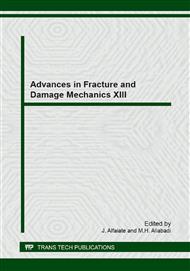p.325
p.329
p.333
p.337
p.341
p.345
p.349
p.353
p.357
An Integrated Creep-Fatigue Theory for Material Damage Modeling
Abstract:
This paper presents an integrated creep-fatigue (ICF) theory to describe the non-linear creep-fatigue interaction during thermomechanical loading. The ICF theory recognizes the damage evolution as a holistic process consisting of nucleation and propagation of surface or subsurface cracks in coalescence with internally distributed damage, leading to final fracture. In a polycrystalline material under combined cyclic and dwell loading, crack nucleation and propagation occurs by fatigue or oxidation mechanisms, whereas internally distributed damage often occurs in the form of grain boundary cavities or microcracks due to creep or dwell effects, particularly at high temperatures. Based on the above mechanism, a damage evolution equation is mathematically derived, and the generality of the above physical mechanisms warrants the applicability of the ICF theory over a wide range of stresses and temperatures. This paper uses Mar-M 509, a cobalt base superalloy, as an example to illustrate how the ICF theory describes creep and low cycle fatigue (LCF).
Info:
Periodical:
Pages:
341-344
Citation:
Online since:
September 2014
Authors:
Keywords:
Price:
Сopyright:
© 2015 Trans Tech Publications Ltd. All Rights Reserved
Share:
Citation:


